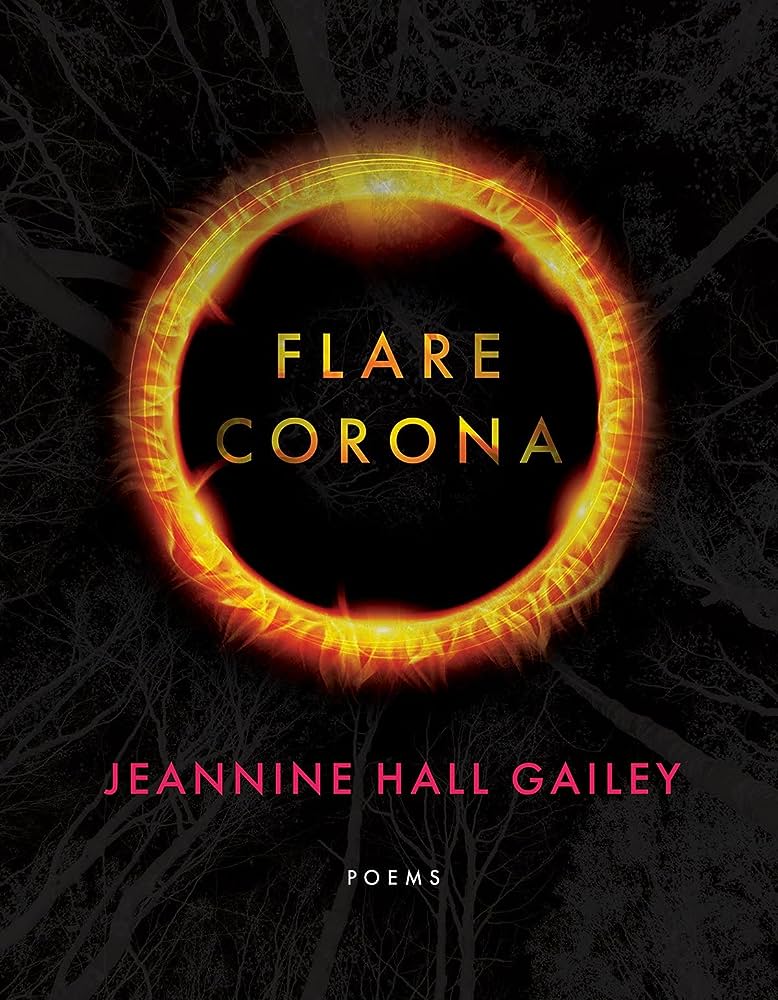
A Review of Flare, Corona by Jeannine Hall Gailey
Words By JP Legarte
The coronavirus, a multiple sclerosis diagnosis, the collapse of environmental rhythms, and the conundrum between grief and strength—in Flare, Corona, Jeannine Hall Gailey shows she is not afraid to tackle catastrophe on both global and personal scales. In fact, this collection of poems from Gailey juxtaposes her multiple sclerosis diagnosis and its associated symptoms against the greater context of disaster on a world level, crafting poems in the form of self-portraits, mutant sonnets, and overarching intersections of grief, anger, and perseverance. Ultimately, Flare, Corona navigates a narrative nestled between the personal body and the larger world and explores the entropy in this complicated yet relatable space.
At the end of the first poem of the collection titled “Irradiate,” Gailey writes, “I meant I was full of / radiation. I meant I was full of light. / I meant I could give birth to nothing / but light.” Aside from the effective use of enjambment that splits the last line, I wanted to start here because these statements can be considered the thesis statement for the whole collection. Gailey identifies the complexity of the body as a simultaneous destructor and life-giver while using the body to represent the nature of the world too. Gailey seamlessly zooms in and out from poem to poem—sometimes even within a singular poem—to demonstrate that we cannot escape the calamity of our own body because we are reminded of it in the calamity of our own world, and vice versa. For example, the very next poem “Calamity” mentions headless robots, a meteor, Godzilla, and family coming over for Thanksgiving. What a string of events, right? Then, Gailey ties all these back to mortality by offering to the body a call to act amidst the calamity, writing, “Who are you wearing? Because tonight / your life will be required of you. Grab a bag, / a sword, a water bottle. Go out swinging.”
Such similar strings can be found in all the poems throughout the four sections titled “Post-Life,” “Harbingers,” “Blood Moon,” and “Corona.” In “Post-Life,” the speaker focuses on the topic of death, how she herself has evaded death thus far, and what happens when the physical body does inevitably give out. In the case of “Harbingers,” the speaker sustains the sense of foreboding from “Post-Life” and considers phenomena that hint at the future, one that appears as apocalyptic as it is tragic. Though “Blood Moon” and “Corona” are separate sections, their mood and tone feel similar in the sense that blood moon is another word for a lunar eclipse, a time when the moon is darkened and reddened—what seems to be a literary way to convey the darkness and “redness” of “Corona” that refers to the time of the pandemic. While I was able to identify why some poems were in specific sections, I found that a lot of the poems touch on almost the exact same topics in very similar ways. I believe that this happens naturally when poetry collections have a central theme. That being said, the similarities in both topics and poetic strategies stacked to the extent that, the further I went into the collection, the more everything started to blend in my mind and, subsequently, fade in the background, even as the cycle of foreboding and hope was well sustained.
The language of the poetry in Flare, Corona is an example where an abundance of straightforward statements serves as a double-edged sword. On one hand, the poetic craft strategy of straightforward language ensures that Gailey reduces the risk of overcomplicating her messages and retains her honest feelings on the topics she explores. On the other hand, the choice to lean on such straightforwardness throughout makes the collection feel like one blended narrative and left me wishing for more moments where Gailey plays with language like in the poem “Self-Portrait as MRI”: “The face-cage, the thumping echo chamber / coffin-tube, nothing romantic about this enforced / stillness, this live burial. The invisible magnet’s fingers / deciding: this brain this joint this blood this scar this bone.” However, whatever the type of language used, I never stopped feeling the emotional weight and authenticity poured into every poem, suggesting that the only way to tell certain stories and their intricacies is to tell them as they are.
Throughout its exploration of pandemic, post-life, present life, and perseverance, Flare, Corona ultimately points to the strength that humanity still has in the face of the sorrow and hysteria the world heaves our way, even if that strength isn’t always prevalent. Through upfront honesty and the undeniable emotional threads that balance the language, Gailey crafts a collection that prompts us to reflect on our own responses—physical, emotional, and otherwise—to an ever-changing world. I believe Gailey frames our hope—no matter how big or small—best in “A Story for After a Pandemic,” when she writes, “We will never again take for granted / a dance, a kiss, a crowd, we promise. A farmer’s market / and candy apples, a county fair, kettle corn. / It’s all miracles. We gather in small groups / and tell the stories; who we lost, what we will remember.”